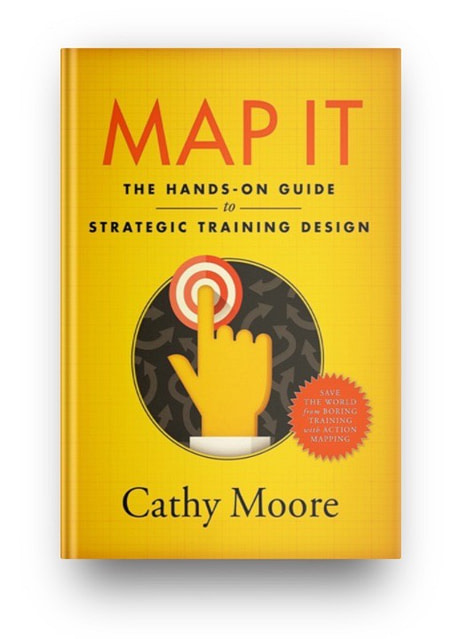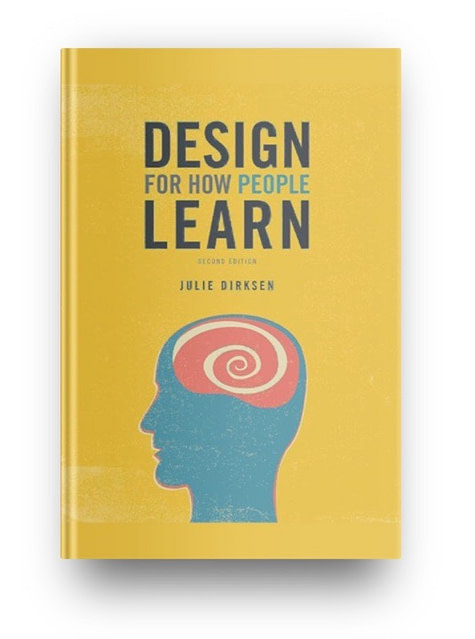Instructional design books can be a precious resource for gaining unique insights about digital course creation. For one, they can help you develop more engaging e-learning courses – but that’s not all. These books also contain the connecting fundamental principles for building an efficient business by designing the proper training for your organization.
In this article, we will go through our top five instructional design books and explain how they can aid in creating better experiences for successful learning.
The basics of instructional design
Let’s start with the principles that all instructional designers should remember. Professionals often recommend two popular books to boost the instructional design process and create better online courses. They are “Map It: The Hands-on Guide to Strategic Training Design” and “Design for How People Learn.”
Map It: The Hands-on Guide to Strategic Training Design, by Cathy Moore

Cathy Moore is one of the leaders of the instructional design movement, and her book “Map It: The Hands-on Guide to Strategic Training Design” is an exceptional resource for instructional designers and professionals seeking to tackle performance problems in businesses through strategic training design.
This book provides a comprehensive and practical approach to mapping, a technique that identifies and resolves performance gaps within organizations. Moore focuses, in particular, on the importance of understanding the underlying causes of performance problems before developing training solutions. She also suggests moving from a traditional “order-taking” approach to a more consultative role where the instructional designer can also partner with stakeholders to create targeted and effective interventions.
Through practical examples and case studies, “Map It: The Hands-on Guide to Strategic Training Design” systematically analyzes business goals, identifying desired outcomes and mapping a roadmap to address the critical tasks and skills required to achieve them. As a result, instructional design professionals can align their training programs with the organization’s performance problems.
Design for How People Learn, by Julie Dirksen

“Design for How People Learn” by Julie Dirksen is a highly informative and practical book that explores the intersection of cognitive psychology and instructional design. In particular, this resource offers valuable insights into creating compelling learning experiences by understanding how people process and retain information.
Dirksen adeptly explains vital concepts from cognitive psychology and demonstrates how they can be applied to instructional design. For example, she emphasizes the significance of mental processes such as attention, memory, and problem-solving when designing learning materials and how they can optimize learning outcomes and enhance knowledge retention.
This book also covers the importance of feedback in learning, highlighting how well-structured and timely feedback can reinforce learning, correct misconceptions, and motivate learners. Another compelling aspect of “Design for How People Learn” is its exploration of storytelling as a powerful instructional tool. In particular, Dirksen underscores the value of narratives in capturing learners’ attention and facilitating more profound understanding.
Additional instructional design strategies
Some instructional design strategies go beyond the foundational principles and techniques, offering innovative approaches and specialized methods to engage learners and optimize knowledge retention. From gamification and microlearning to adaptive learning and social collaboration, these strategies provide valuable insights and practical tips to take your instructional design efforts to the next level. Here are our top recommendations.
The Accidental Instructional Designer: Learning Design for the Digital Age, by Cammy Bean

This book is an excellent resource for instructional designers navigating the realm of online learning, as it focuses on practical guidance and insights for beginners and professionals approaching e-learning.
One of the key takeaways from “The Accidental Instructional Designer” is the importance of user-centered design. In particular, how important it is to understand learners’ needs, motivations, and preferences when designing online learning experiences. Another notable aspect of the book is its focus on integrating technology and media in online learning design (especially multimedia elements and interactivity options to enhance engagement).
Cammy Bean recognizes the evolving landscape of digital education and guides readers through creating compelling and engaging online learning experiences. From understanding the online learner’s perspective to designing interactive and multimedia-rich content, the book covers various topics essential for success in the digital age in an approachable and engaging way. “The Accidental Instructional Designer” also includes step-by-step instructions for approaching online course design and confidently navigating the digital realm’s intricacies.
e-Learning and the Science of Instruction, by Ruth Colvin Clark and Richard Mayer

This book is another excellent resource for designing effective e-learning courses. The guide is, in fact, ideal for instructional designers and educators looking to focus on online courses. It serves as a valuable reference for harnessing the potential of technology and science in the digital age.
Clark and Mayer draw from cognitive science research to outline evidence-based instructional strategies that maximize learning outcomes in digital contexts. For instance, they focus on the unique characteristics of e-learning, such as learner autonomy and asynchronous delivery. They include practical guidelines for creating engaging and interactive online courses.
Another highlight is the book’s exploration of multimedia elements like graphics, audio, and video and how they can enhance learning by engaging multiple senses and improving knowledge retention.
The authors emphasize that passive content consumption does not lead to optimal learning outcomes. Instead, they advocate for interactive and learner-centered activities that require learners to engage with the material actively.
Designing Effective Instruction, by Gary R. Morrison, Steven M. Ross, and Jerrold E. Kemp

“Designing Effective Instruction” is a comprehensive and insightful book that delves into the principles and practices of designing instruction that is both effective and efficient. This book serves as a valuable resource for instructional designers, educators, and anyone involved in creating impactful learning experiences.
The authors emphasize the importance of aligning instructional goals with desired learning outcomes, ensuring that all activities are purposeful and directly contribute to the intended results. The book also provides practical guidance on streamlining instructional design processes and extensively covers instructional strategies, offering a wide range of proven approaches to engage learners. Lastly, “Designing Effective Instruction” highlights the role of assessment in evaluating learner progress, identifying knowledge gaps, and informing instructional adjustments.
From direct instruction and problem-based learning to cooperative learning and multimedia design, the authors provide a wealth of options for instructional designers to choose from. Each strategy is also explained in detail, with insights into its theoretical foundations, practical implementation considerations, and examples of successful applications.
Conclusion
We’ve covered some of the best resources to learn about instructional design, including core principles, the e-learning design process, and even project management and course design.
If you’re looking to learn the basics of instructional design, both “Map It: The hands-on guide to strategic training design,” by Cathy Moore, and “Design for How People Learn,” by Julie Dirksen, are excellent resources that address the importance of mapping and using cognitive psychology to create compelling learning experiences.
“The Accidental Instructional Designer: Learning Design for the Digital Age,” by Cammy Bean, and “e-Learning and the Science of Instruction,” by Ruth Colvin Clark and Richard Mayer, are two perfect guides to approaching online learning and how you can motivate learners to engage with course materials. “Designing Effective Instruction,” by Gary R. Morrison, Steven M. Ross, and Jerrold E. Kemp, on the other hand, delves into how to make instruction more effective and efficient and covers several valuable strategies.
We recommend all of these instructional design books and encourage readers to use them to become experts in the field.

By Yisela Alvarez Trentini
Anthropologist & User Experience Designer. I write about science and technology. Robot whisperer. VR enthusiast. Gamer.
